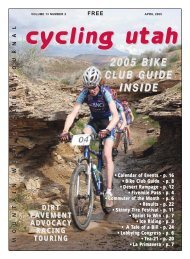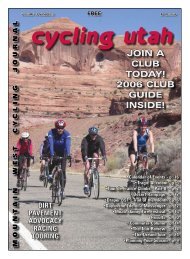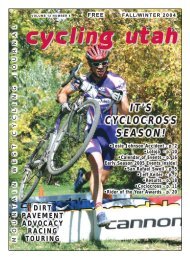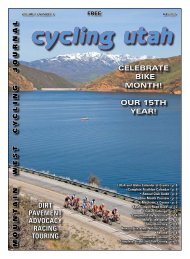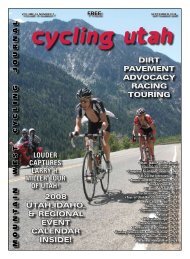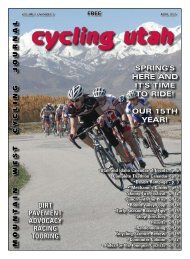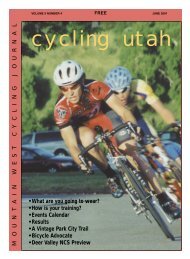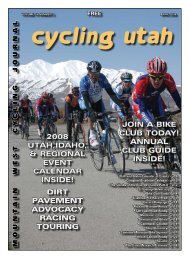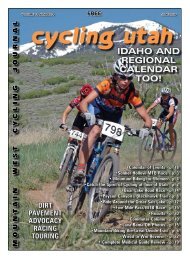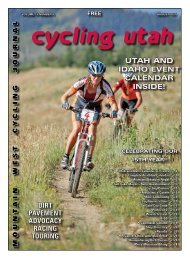Create successful ePaper yourself
Turn your PDF publications into a flip-book with our unique Google optimized e-Paper software.
JUNE <strong>2008</strong> cycling utah.com 17commuter of the MonthRadical and Rational Thinking From Outside the Bike BoxBy Lou MeliniI have never seen William Atheyor Richard Peterson in a car. Bothare seen riding their bikes everywhereon the streets of Salt LakeCity. Fifty-Five-year-old WilliamAthey traces his bicycle commutingback to the “70’s, riding fromGranger to the University. He thendrove cars for a short time, followedby buses and taxis for a few years.For the past 8 years he has used abike, ditching the buses when herealized it was quicker and easierto get around on a bike exclusively.William has a Marketing degreefrom Westminster College plussome graduate work in ProfessionalCommunications. William has hada number of music related jobs, butis currently employed at the SLClibrary. He has had a few otherinteresting positions, such as a legalobserver for the ACLU of <strong>Utah</strong> duringthe Winter Olympics riding hisbike in temperatures that hit highsof 20°.Richard Peterson has also beena life-long cyclist, tracing his seriousriding back to the “70’s whenhe rode from his undergraduateUniversity of Arizona to Cornell inNew York. This helped inspire himto study air pollution. He eventuallyobtained his PhD in 1986 fromthe University of Washington inSeattle. Due to his research, he hasbeen able to ride in many parts ofthe U.S. as well as in Germany. Heand his wife Bonnie have done severalbike tours in the U.S., Canada,Germany and most of the rest ofEurope. He is currently a Professorof Chemistry at the U. but will bemoving to the Republic of Trinidadand Tobago at the time of this columnis published.<strong>Cycling</strong> <strong>Utah</strong>: William, you have aninteresting collection of bikes. Youalso seem to be well dressed no matterwhat the weather is like.William Athey: I currently have 8bikes, all purchased at yard sales,and all are perfectly in tune andready to ride. My winter bike, aStumpjumper, cost me $35. It has aGMC Yukon faceplate mounted onthe handlebar. When it’s snowing Isay, “Honey, I’m taking the Yukonto work”. In winter I wear an oldsnowboard helmet and ski goggles.I also picked up some waterproof/repellant pants, jackets and gloves.I use a pair of studded tires that alibrary patron donated to me.During the summer, I ditch thehelmet, and ride as close to nakedas I can get. I usually use a backpackto pack my clothes. I ride avariety of bikes, all being variousmountain bikes costing me as littleas $10. I have mounted ArmadilloNimbus tires on most of the bikes.These tires do not get flats. I love toride the Jordan River Parkway, thebicyclist’s nightmare for goat headthorns, and no flats.C.U.: William, your long hair and“homeless” appearance on your bikehave caused you a little harassment.I also hear you were the first criticalmass rider to receive a ticket.W.A.: The police officer admittedin court he singled me out dueto my appearance, which helpedin dismissal of the ticket fromthe Critical Mass ride. Judge Gillrecently visited the library and toldme he still remembers the case andthe police officer’s statement. Thelast time I went to a bicycle advisorycommittee meeting, the guardescorted me to the meeting. On 2occasions I have been accused ofburglarizing my own home afterarriving home on a bicycle with mybackpack. New neighbors accostedme, detained me, and threatened tocall the police, until I proved that Iwas entering my own home, withmy own key.C.U.: William you no longer doCritical Mass (CM) rides; Richardyou still do them. Why is CriticalMass important? Are all CM ridesalike? Does CM contribute to theacceptance of biking in a communityor does it provoke a backlashagainst cyclists?W.A.: Critical Mass is supposedto be a celebration of bicycling.Everyone is supposed to be welcomeand everyone has his or herown reason for riding. I did it as anact of civil disobedience. We shutdown State St., 700 East, 500 Southand 600 South during rush hour. Yeswe angered many motorists in theinterest of promoting bicycling, butsome did calm down after readingthe flyers we passed out. One day amonth for one hour, motor vehicleswere inconvenienced and bicyclestook over the streets. By nature allCM rides are different, the route andthe motor vehicle action will alwaysbe different. CM can contribute toacceptance of bikes in a community.Many times numerous cars honkedin support and cheered the effort.So in answer to your question, theanswer is yes, no and sometimes. Iquit doing CM rides when the spiritof CM became violated. People rodeblocks ahead of slower riders and onone occasion a homeless man on abike joined the group. This wasn’t“approved” and he was harassed.That ended it for me.Richard Peterson: I still ride CriticalMass. Some mess with cagers (cars),some don’t. Some riders obey trafficlaws, some don’t. Some wearhelmets, some don’t. We just havefun. Overall I think CM is neithera positive or negative influence oncommuting. I see many more redlight, stop sign and other traffic lawsignored by drivers and cyclists otherthan Critical Mass riders. It justgives the participants a chance toride together and have fun.C.U.: I hear a lot of people say thatmore bike lanes and segregated bikepaths would more likely changethem from driving a car to riding abike to work. Is this a prime reasonfor people not riding to work?W.M.: No, they don’t want to rideto work. They think it is dangerous.It IS NOT dangerous! Mostpeople aren’t going to ride in rain,snow, or 100 degree heat, no matterhow many bike lanes or segregatedbike paths there are. Location is ahuge factor. I chose to live where Ican bike to get around as opposedto most people who choose to livebased on car use.R.P.: Bike lanes are not the reasonfor not commuting.C.U.: We currently have the mostbike friendly administration in thehistory of Salt Lake. What are 3things that must be done for thisadministration to successfully claimto make SLC more bike friendly?W.A.: Education is number onefor both bicyclists and motorists.Personally I believe the effort isimpossible as there are too manyidiots in cars. How can the Mayorreach them? Enforcement is next,especially cars, but bicycles also.Enforce the 3-foot law! Finallymaintain and improve the bikeroutes. 1700 South is a bike route,it is also has buses, and it is barelywide enough for 2 cars! Thereshould be pedestrian/bike bridgesspanning the RR tracks on 1700South and 800 South. I could go on.Make the bike routes rideable!R.P.: 1. Enforce the laws againstcars; cars kill! 2. Enforce the lawsfor bikes, but bikes do not kill 3.Enforce the laws for cars; cars kill— did I say that already; I guess itneeds to be said again.C.U.: My personal bias is that wewill not see an increase in bicyclecommuting until there is a significantjump in gasoline prices. Whatare your thoughts about this andhow high does this increase needto be?W.A.: I agree with you on this one.Every dollar increase will see acoinciding increase in bicyclists.However if this occurs UTA mustbe prepared for a dramatic increaseof bikes on buses and TRAX. Whatis UTA’s plan when 10 people arewaiting to board a bus that onlyallows 2 bikes?R.P.: I currently doubt that the priceof gas has much influence on peopleleaving cars. After all, the cost ofpurchasing, financing, maintaining,insuring, and registering a car aremuch higher costs than the fuel costwhich the American public continuesto pay. American foreign policyhas shown that it is willing to killpeople for control of oil. What’s $4a gallon compared to that!C.U.: Do cyclist dressed in “civilian”clothing vs. bike clothing getmore respect from drivers? What arethe impacts on how we look on theroad affect public perception?W.A.: Read the citizen commentswhenever any bicycle-related storyappears on the television news or inthe newspaper. There is a frighteningamount of hatred and anger directedat what I call Captain Underpants.These are club riders, the fair-weather,weekend warriors wearing brightcostumes. They are despised andthat hatred is sometimes directedmy way. Why? Because a certainpercentage of the group are arrogant,completely ignoring all trafficordinances. They’ve flipped me offand yell obscenities at me, a fellowcyclist. They are highly visible,good for their safety, but bad dueto the misbehavior of the few. Dueto the stunning amount of hatredexpressed on local comment boards,I feel safer rider in my civilianclothing. Visibility and appearanceare important, but behavior is farmore important. I’m almost startingto believe that a safety courseand bicycle operator licenses arerequired.R.P.: My wife Bonnie is convincedthat she gets more space when she isin civilian clothes and not wearing ahelmet. My experience agrees.C.U.: William, you have sent manycomments from the KSL commentboard to the MBAC. What is theimportance of image of cyclists inthe public eye? How does this affectour rights and safety on the road?Richard Peterson in Maui.W.A.: I mostly answered this inthe above question. There are afew distinct groups of cyclists thatseem to think that the laws do notapply to them. These groups are thetarget or subject of, virtually all thevitriol directed cyclist’s way on thecomment boards. I mentioned onegroup. Another group are the poor,many are immigrants from countrieswhere riding in the opposite directionof traffic is common. How canany education effort reach the membersof this group? The 3rd sprungup fairly recently whom also thinkthat traffic ordinances do not applyto them. Most importantly, aboveattire or anything else, a bicyclistriding with confidence, obeyingtraffic ordinances, gives the motorvehicle operating public a positiveimpression.C.U.: Richard, you have riddenextensively in Germany. What is theprinciple differences affecting therelationship of drivers and cycliststhere vs. here?R.P.: Respect for the law. Peopletypically obey traffic laws whetherin a car or on a bike. The culture isbig on personal responsibility. It isnot an “accident” if you hit someonebecause you are ignoring the rules.In some European countries, thefault is always on the bigger vehicle.If a bike hits a pedestrian, it is thecyclist’s fault. If a car hits a bike,it is the driver’s fault. In Germany,all streets are “Complete Streets”.<strong>Cycling</strong> and walking are relativelysafe. People of all ages walk andride all year round. How often doyou see old ladies doing their shoppingon a bike here in SLC? InMuenster that is the norm. Manystores don’t even have parking forcars.C.U.: Richard, As a Professor ofchemistry I want to know whatyou think of the “Red, Yellow, andGreen” alerts the State Division ofAir Quality publishes in the wintertime.Is this system effective?Personally, it seems that peopledrive more on red days. Am I correct?Do you have any alternativesolutions?R.P.: I have had my students maketraffic counts and the color codesseem to make little if any difference.Typical solutions globally are to banprivate motor vehicles in affectedareas and give free public transit. Itis odd that our presidential candidateswant to lower gas taxes. Thegas tax should be retained, in factincreased with the revenue put intofree public transit This would actuallybenefit air quality.If you have a suggestion for acommuter profile, have a commuterquestion you wish me toaddress, or other comments,please send them to lou@cyclingutah.com.



